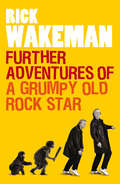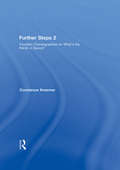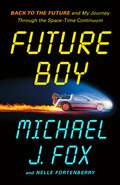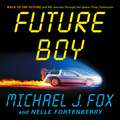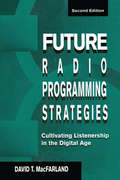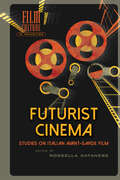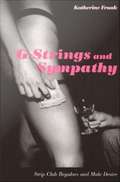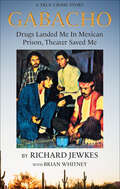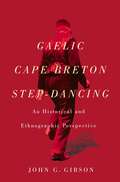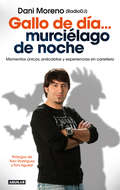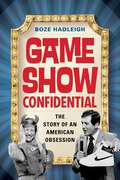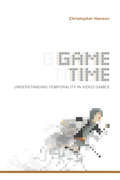- Table View
- List View
Further Adventures of a Grumpy Old Rock Star
by Rick WakemanWhat do Postman Pat, Tommy Cooper, Norman Wisdom and George Best have in common with being abandoned in a Costa Rican jungle after a severe bout of flatulence? Indeed, how are they also connected to trying to buy an Australian brewery just to get a beer, owning twenty-two cars, an American soccer team and a Swiss mail-order pornography company?The common feature is of course a certain Richard Wakeman.The Further Adventures of a Grumpy Old Rock Star takes you, the privileged reader, on a trip of absurd excess, a cultural car crash of side-splitting hilarity and an unforgettable glimpse (again) into the life of one of Britain's most legendary showmen, rock stars and all-time great raconteurs.
Further Steps 2: Fourteen Choreographers on What's the R.A.G.E. in Modern Dance
by Constance KreemerFurther Steps 2 brings together New York’s foremost choreographers – among them MacArthur ‘Genius’ award winners Meredith Monk and Bill T. Jones – to discuss the past, present and future of dance in the US. In a series of exclusive and enlightening interviews, this diverse selection of artists discuss the changing roles of race, gender, politics, and the social environment on their work. Bringing her own experience of the New York dance scene to her study, Constance Kreemer traces the lives and works of the following choreographers: Lucinda Childs, Douglas Dunn, Molissa Fenley, Rennie Harris, Bill T. Jones, Kenneth King, Nancy Meehan, Meredith Monk, Rosalind Newman, Gus Solomons jr, Doug Varone, Dan Wagoner, Mel Wong and Jawole Zollar.
Future Boy: Back to the Future and My Journey Through the Space-Time Continuum
by Michael J. Fox Nelle FortenberryINSTANT NEW YORK TIMES BESTSELLERA poignant, heartfelt, and funny memoir about how, in 1985, Michael J. Fox brought to life two iconic roles simultaneously—Alex P. Keaton in Family Ties and Marty McFly in Back to the Future. An amazing true story as only Michael J. Fox can tell itIn early 1985, Michael J. Fox was one of the biggest stars on television. His world was about to get even bigger, but only if he could survive the kind of double duty unheard of in Hollywood. Fox’s days were already dedicated to rehearsing and taping the hit sitcom Family Ties, but then the chance of a lifetime came his way. Soon, he committed his nights to a new time-travel adventure film being directed by Robert Zemeckis and produced by Steven Spielberg—Back to the Future. Sitcom during the day, movie at night—day after day, for months.Fox’s nightly commute from a soundstage at Paramount to the back lot at Universal Studios, from one dream job to another, would become his own space-time continuum. It was in this time portal that Alex P. Keaton handed the baton to Marty McFly while Michael J. Fox tried to catch a few minutes of sleep. Alex’s bravado, Marty’s flair, and Fox’s comedic virtuosity all swirled together to create something truly special.In Future Boy, Fox tells the remarkable story of playing two landmark roles at the same time—a slice of entertainment history that’s never been told. Using new interviews with the cast and crew of both projects, the result is a vividly drawn and eye-opening story of creative achievement by a beloved icon.
Future Boy: Back to the Future and My Journey through the Space-Time Continuum
by Michael J FoxA poignant, heartfelt and funny memoir about how, in 1985, Michael J Fox brought two iconic roles to life simultaneously - Alex Keaton in Family Ties and Marty McFly in Back to the Future. Here is the amazing true story, as only Michael J Fox can tell it ...In early 1985, Michael J. Fox was one of the biggest stars on television. His world was about to get even bigger, but only if he could survive the kind of double duty unheard of in Hollywood. Fox's days were already dedicated to rehearsing and taping the hit sitcom Family Ties, but then the chance of a lifetime came his way. Soon, he committed his nights to a new time-travel adventure film being directed by Robert Zemeckis and produced by Steven Spielberg, Back to the Future. Sitcom during the day, movie at night - day after day, for months.Fox's nightly commute from a soundstage at Paramount to the back lot at Universal Studios, from one dream job to another, would become his own space-time continuum. It was in this time portal that Alex P. Keaton handed the baton to Marty McFly while Michael J. Fox tried to catch a few minutes of sleep. Alex's bravado, Marty's flair, and Fox's comedic virtuosity all swirled together to create something truly special.In Future Boy, Fox tells the remarkable story of playing two landmark roles at the same time - a slice of entertainment history that's never been told. Using new interviews with the cast and crew of both projects, the result is a vividly drawn and eye-opening story of creative achievement by a beloved icon.Excerpts and quotes from Back to the Future, Copyright 1985 Universal City Studios, Inc., Courtesy of Universal Studios Licensing LLC
Future Noir: The Making of Blade Runner
by Paul M. SammonUpdated edition: The ultimate guide to Ridley Scott’s transformative sci-fi classic Blade Runner, with photos, new cast interviews, and more.Based on Philip K. Dick’s brilliant and troubling science fiction masterpiece Do Androids Dream of Electric Sheep?, Blade Runner is among the most visually dense, thematically challenging, and influential science fiction films ever made. Future Noir offers a deeper understanding of this cinematic phenomenon that is storytelling and visual filmmaking at its best.In an intensive, intimate, and anything-but-glamorous behind-the-scenes account, Paul M. Sammon explores how Ridley Scott purposefully used his creative genius to transform the work of science fiction’s most uncompromising author into a critical sensation and cult classic that would reinvent the genre. Sammon reveals how the making of the original Blade Runner was a seven-year odyssey that would test the stamina and the imagination of writers, producers, special effects wizards, and the most innovative art directors and set designers in the industry at the time it was made. This revised and expanded edition of Future Noir includes:An overview of Blade Runner’s impact on moviemaking and popular culture An exploration of the history of Blade Runner: The Final Cut and its theatrical release in 2007A look at its long-awaited sequel, Blade Runner 2049The longest interview Harrison Ford has ever granted about Blade RunnerExclusive new interviews with Rutger Hauer and Sean YoungA fascinating look at the ever-shifting interface between commerce and art, illustrated with production photos and stills, Future Noir provides an eye-opening and enduring look at modern moviemaking, the business of Hollywood, and one of the greatest films of all time.
Future Radio Programming Strategies: Cultivating Listenership in the Digital Age (Routledge Communication Series)
by David MacFarlandFundamental beliefs is what the reader will be exploring here -- a common understanding of what the radio enterprise should be about: entertainment and information. A major thrust of this book is to arrive at a set of fundamental beliefs about the values and realities of the radio business in regard to entertainment programming -- a set of beliefs that may or may not be right, true, or forever, but that might at least provide a basis for developing programming strategies. This second edition of Future Radio Programming Strategies seeks to answer the question: "What do listeners really want from radio?" Some of the answers are derived from "users-and-gratifications" research in the mass media. Instead of focusing on what mass media do to people, the users-and-gratifications perspective seeks to discover what people do with mass media. The functionalist viewpoint of such research basically says that a medium is best defined by how people use it. Having looked at some of the audience research that comes from sources other than the standard ratings companies, the book then goes on to demonstrate new ways that formats, production procedures, and announcing styles can meet audience needs and desires. Although the volume concludes with several original methods for selecting and presenting airplay music based on the audience's moods and emotional needs, it does not insist upon a singular, formulaic approach for constructing or modifying a music format. Instead, it attempts to involve the reader in thinking through the process of format development. Two audio tapes are also available for use with the book. The tapes contain nearly 3 hours of important, detailed information and provocative points from the book. Exclusive audio examples include: * the sense of acoustic space in music; * hi-fi versus lo-fi listening environments; * subjective perception of the announcer's distance from the listener; * audio editing rates; * comparison of luxury versus inexpensive car listening experiences; and * the components of emotions that are expressed vocally. The tapes also include new sections about the threats to traditional radio from specialized digital audio services, competition for the listener's attention from computer-based media, and additional proof of how music can be chosen on the basis of listeners' emotional reactions and mood needs.
Futures of Performance: The Responsibilities of Performing Arts in Higher Education
by Schupp KarenFutures of Performance inspires both current and future artists/academics to reflect on their roles and responsibilities in igniting future-forward thinking and practices for the performing arts in higher education. The book presents a breadth of new perspectives from the disciplines of music, dance, theatre, and mediated performance and from a range of institutional contexts. Chapters from teachers across various contexts of higher education are organized according to the three main areas of responsibilities of performing arts education: to academia, to society, and to the field as a whole. With the intention of illuminating the intricacy of how performing arts are situated and function in higher education, the book addresses key questions including: How are the performing arts valued in higher education? How are programs addressing equity? What responsibilities do performing arts programs have to stakeholders inside and outside of the academy? What are programs’ ethical obligations to students and how are those met? Futures of Performance examines these questions and offers models that can give us some of the potential answers. This is a crucial and timely resource for anyone in a decision-making position within the university performing arts sector, from administrators, to educators, to those in leadership positions.
Futurist Cinema: Studies on Italian Avant-garde Film (Film Culture in Transition)
by Rossella CataneseFuturism and early cinema shared a fascination with dynamic movement and speed, presenting both as harbingers of an emerging new way of life and new aesthetic criteria. And the Futurists quickly latched on to cinema as a device with great potential to manipulate our perceptions in order to create a new world. In the edited collection Futurist Cinema, Rossella Catanese explores that conjunction, bringing in avant-garde artists and their manifestos to show how painters and other artists turned to cinema as a model for overcoming the inherently static nature of painting in order to rethink it for a new era.
Fëdor Khitruk: A Look at Soviet Animation through the Work of One Master
by Laura PontieriThis book is a first and long-awaited study of the directorial work of the animation master Fëdor Khitruk (1917–2012), an artist who formed in the tradition of classical cel animation only to break the conventions once he turned into a director; a liaison between artists and authorities; a personality who promoted daring films to be created in the Soviet Union dominated by socialist realism; and a teacher and supporter of young artists that continued to carry on his legacy long after the Soviet empire collapsed. Fëdor Khitruk: A Look at Soviet Animation through the Work of One Master reveals Khitruk’s mastery in the art of the moving image and his critical role as a director of films that changed the look of Soviet animation and its relation to the animation world within and beyond the Eastern Bloc. Based on archival research, personal interviews, published memoirs, and perceptive analyses of Khitruk’s production of films for children and adults, this study is a must-read for scholars in Soviet art and culture as well as readers fascinated by traditional animation art.
G-Strings and Sympathy: Strip Club Regulars and Male Desire
by Katherine FrankBased on her experiences as a stripper in a city she calls Laurelton--a southeastern city renowned for its strip clubs--anthropologist Katherine Frank provides a fascinating insider's account of the personal and cultural fantasies motivating male heterosexual strip club "regulars. " Given that all of the clubs where she worked prohibited physical contact between the exotic dancers and their customers, in G-Strings and Sympathy Frank asks what--if not sex or even touching--the repeat customers were purchasing from the clubs and from the dancers. She finds that the clubs provide an intermediate space--not work, not home--where men can enjoyably experience their bodies and selves through conversation, fantasy, and ritualized voyeurism. At the same time, she shows how the dynamics of male pleasure and privilege in strip clubs are intertwined with ideas about what it means to be a man in contemporary America. Frank's ethnography draws on her work as an exotic dancer in five clubs, as well as on her interviews with over thirty regular customers--middle-class men in their late-twenties to mid-fifties. Reflecting on the customers' dual desires for intimacy and visibility, she explores their paradoxical longings for "authentic" interactions with the dancers, the ways these aspirations are expressed within the highly controlled and regulated strip clubs, and how they relate to beliefs and fantasies about social class and gender. She considers how regular visits to strip clubs are not necessarily antithetical to marriage or long-term heterosexual relationships, but are based on particular beliefs about marriage and monogamy that make these clubs desirable venues. Looking at the relative "classiness" of the clubs where she worked--ranging from the city's most prestigious clubs to some of its dive bars--she reveals how the clubs are differentiated by reputations, dress codes, cover charges, locations, and clientele, and describes how these distinctions become meaningful and erotic for the customers. Interspersed throughout the book are three fictional interludes that provide an intimate look at Frank's experiences as a stripper--from the outfits to the gestures, conversations, management, coworkers, and, of course, the customers. Focusing on the experiences of the male clients, rather than those of the female sex workers, G-Strings and Sympathy provides a nuanced, lively, and tantalizing account of the stigmatized world of strip clubs.
GILDED BLOOD COMPLETE SERIES
by Rachel RenerGet ready to dive into a thrilling, action-packed world where magic, romance, and tattoos collide. Follow Talia, a quirky art school dropout, as she navigates a wild journey through two realms—one where ink and blood hold untold power and another where fae, incubi, and the unthinkable exist. From forbidden love to dangerous magical secrets, this complete four-book series is a rollercoaster of laughs, heartbreak, and epic battles.
GUÍA PARA EL CINE DE STEPHEN KING (Con las entrevistas a Mick Garris y Dee Wallace)
by Marcello Gagliani Caputo Traducción de Julio César Navarro VillegasUn viaje por las cintas y las series de televisión tomadas de las novelas y los relatos de Stephen King. De "Carrie" a "La cúpula", historia, génesis, documentos y curiosidades. Con las entrevistas a Mick Garris y Dee Wallace. Pocos escritores han logrado condicionar el cine como Stephen King, desde los años '70 hasta hoy, casi todas sus novelas han sido llevadas a la pantalla grande o a la televisión, síntoma de la extraordiaria capacidad del autor estadounidense para contar historias construidas justamente para transformarse en imágenes. Directores como Brian De Palma, Stanley Kubrick, Rob Reiner y Frank Darabont, sólo por citar algunos, se han popularizado con la transposición de un libro de King, obteniendo en algunos casos un éxito estrepitoso, en otros dando un giro radical a la propia carrera. El primero, en 1976, fue De Palma con "Carrie", su segundo largometraje, obteniendo el pasaporte para la gloria, seguido al poco tiempo por Tobe Hooper que llevó a la tv "La hora del vampiro" (1978) y sobre todo Stanley Kubrick y "El resplandor" (1980), motivo de infinitas polémicas entre el director y King, quien se ha declarado contrario a la relectura cinematográfica de su novela. Partiendo de estas bases, pero yendo mucho más allá, el libro recorre las etapas fundamentales que han hecho del autor estadounidense uno de los más "disfrutados" del cine, pero que también lo han visto involucrarse directamente (suya es la dirección de "Ocho días de terror" así como muchos de los guiones de otras cintas). Con un prefacio de Stefano Pastor ("Il giocattolo" y "Figlio che odiano le madri", de Fazi editore), desde la filmografía completa y embellecido con las entrevistas a Mick Garris ("La danza de la muerte", "El resplandor" para la tv, "Montando la bala" y otras cintas) y a la protagonista de "Cujo" Dee Wallace, este volumen narra la génesis de todas las películas (o s
Gabacho: Drugs Landed Me In Mexican Prison, Theater Saved Me
by Brian Whitney Richard JewkesA young man&’s rebellion lands him in a Mexican prison, where theater becomes a lifeline in this memoir of angst, crime, friendship and redemption. Richard Jewkes was in his senior year as a University of Utah theater student when he became disenchanted with his strict Mormon upbringing. Over Christmas break, he and a college friend took off for Mexico seeking adventure. If the adventure hadn&’t included smuggling drugs, it might have just been another college road trip. But after a disastrous encounter with a drug cartel, the two young men ended up arrested by Mexican Federales while trying to make it to the US border. When Jewkes and his friend are tossed into a Mexican prison, they anticipate torture, assault, and even death. After a fight with a notorious killer and struggles with tormenting guards, they make a disastrous escape attempt. But ultimately, Jewkes finds his path to survival when he starts a theatre group with a rag-tag bunch of fellow convicts.
Gaelic Cape Breton Step-Dancing: An Historical and Ethnographic Perspective (McGill-Queen's Studies in Ethnic History)
by John GibsonPlacing the phenomenon of Gaelic Cape Breton step-dancing into an historical perspective.
Gaia-Ästhetiken im zeitgenössischen Spielfilm: Das Wahrnehmbar-Werden der Erde in der filmischen Post/Apokalypse (Environmental Humanities #4)
by Friederike AhrensGaia-Ästhetiken entwerfen Figurationen der Erde und ihrer Lebensformen, welche die Menschen dezentrieren und den Fokus auf die Verbindungen zwischen Lebewesen untereinander und dem Unbelebten richten. Diese Ästhetiken sind der Gaia-Theorie entlehnt. In den 1970er Jahren bei der NASA entwickelt, wird sie von Bruno Latour und Isabelle Stengers in den Kontext des Anthropozäns gesetzt. Die Erde als Gaia ist eine mehr-als-menschliche Assemblage, in der die Menschen Knotenpunkte der Verantwortlichkeit darstellen. Filmische Ästhetiken können diese Knotenpunkte wahrnehmbar werden lassen, wie die Spielfilme I Am Legend (2007) und Planet of the Apes (2011-2017) zeigen. Die Filme präsentieren ihren Zuschauer_innen eine Welt in der Post/Apokalypse, in der die Filmfiguren mit dem Eindringen Gaias konfrontiert sind. Sie werden in der Post/Apokalypse kompostiert: Viren dringen in ihre Körper ein, zersetzen ihre Menschlichkeit und lassen sie zum Teil des mehr-als-menschlichen Gaia-Komposts werden.
Gainesville Punk: A History of Bands & Music
by Matt WalkerKnown for The Fest, Less Than Jake and Hot Water Music, Gainesville became a creative hub in the 1980s and '90s for many of punk rock's greats. Whether playing at the Hardback or wild house parties, earnest acts like Against Me!, Spoke and Roach Motel all emerged and thrived in the small northern Florida city. Radon burst onto the scene with chaotic energy while Mutley Chix helped inspire local torchbearers No Idea Records. Through this succinct history, author Matt Walker traces each successive generation's contributions and amplifies the fidelity of the Gainesville scene.
Gallo de día murciélago de noche: Momentos únicos, anécdotas y experiencias en carretera
by Toni Aguilar Dani Moreno Xavi RodríguezEl mágico mundo de la radio ¿Quién no se sentiría orgulloso de levantarse un lunes sabiendo que lo que hace puede cambiar la vida de alguien para mejor? Dani Moreno, radioDJ de Máxima FM, pagaría por ir a trabajar cada día a la radio porque no puede vivir sin ella. En Gallo de día# murciélago de noche encontraremos sus veinte años de carrera como locutor y como DJ. Lo que le ha sucedido delante y detrás de un micrófono, en el escenario, en el estudio, durante las entrevistas a personajes famosos, en el backstage, en la producción, en la publicidad, en las cabinas, en los hoteles, durante los viajes, en los programas en directo, de clubbing. Anécdotas y experiencias diurnas y nocturnas, los oyentes, los mejores DJ del mundo y el reconocimiento: el premio Ondas. Un libro divertido repleto de momentos radiofónicos estelares y sesiones de infarto que surge de la pasión por la música, lleno de positivismo y energía, en el que el Gallo Máximo te cuenta cómo se hizo realidadsu sueño. Una experiencia de lectura interactiva en la que los lectores más marchosos pueden disfrutar -a través de códigos QR- de vídeos en exclusiva, videoclips y de los momentos memorables de Dani Moreno.
Game On! 2017: All The Best Games: Awesome Facts and Coolest Secrets
by Scholastic Imagine Publishing StaffGame On! 2017 is the second edition of this hot new annual! Features information and statistics about all of the most popular games, tips and tricks for gamers, and interviews from gaming's biggest personalities--including game developers and pro gamers! With the help of Imagine Publishing, learn how to dominate the biggest online multiplayer games and unlock the rarest trophies and achievements in different game worlds.
Game On!: Video Game History from Pong and Pac-Man to Mario, Minecraft, and More
by Dustin HansenFind out about the fast and furious growth and evolution of video games (including how they are quickly taking over the world!) by looking at some of the most popular, innovative, and influential games ever, from Pong, the very first arcade game ever, to modern hits like Uncharted. <P><P>Learn about the creators and inspiration (Mario was named after Nintendo's landlord after he barged into a staff meeting demanding rent), discover historical trivia and Easter eggs (The developers of Halo 2 drank over 24,000 gallons of soda while making the game), and explore the innovations that make each game special (The ghosts in Pac-Man are the first example of AI in a video game). <P><P>Whether you consider yourself a hard-core gamer or are just curious to see what everyone is talking about, Game On! is the book for you!
Game Show Confidential: The Story of an American Obsession
by Boze HadleighGame and quiz shows first started appearing on radio broadcasts in the 1930s, led by the CBS network&’s Professor Quiz, hosted by a man who was neither a professor nor even a college graduate, the first of several frauds that seemed to be endemic to the genre. Professor Quiz was followed by other such game shows as Uncle Jim&’s Question Bee and Ask It Basket, which in turn spawned successful box games for at-home play. The show Truth or Consequences made the transition from radio to television in the late 1940s and was so popular that a town in New Mexico was named for the show. Television proved to be the perfect platform for game shows since they were very popular and cheap to produce. Even in reruns today, the older shows still draw huge audiences. This book describes the evolution of the game show, its larger-than-life producers and hosts, as well as the scandals that have rocked it from time to time, including bloopers from such &“adult&” oriented shows as The Dating Game, The Newlywed Game, and Hollywood Squares. This is an entertaining and lively look at an American phenomenon whose popularity doesn&’t seem to be going away.
Game Time: Understanding Temporality in Video Games (Digital Game Studies)
by Christopher HansonPreserving, pausing, slowing, rewinding, replaying, reactivating, reanimating. . . . Has the ability to manipulate video game timelines altered our cultural conceptions of time? Video game scholar Christopher Hanson argues that the mechanics of time in digital games have presented a new model for understanding time in contemporary culture, a concept he calls game time. Multivalent in nature, game time is characterized by apparent malleability, navigability, and possibility while simultaneously being highly restrictive and requiring replay and repetition. Hanson demonstrates that compared to analog tabletop games, sports, film, television, and other forms of media, the temporal structures of digital games provide unique opportunities to engage players with liveness, causality, potentiality, and lived experience that create new ways of experiencing time. Hanson's argument features comparative analysis of key video games titles including Braid, Quantum Break, Battle of the Bulge, Prince of Persia: The Sands of Time, Passage, The Legend of Zelda: The Ocarina of Time, Lifeline, and A Dark Room.
Game of Thrones (Fan Phenomena Ser.)
by Kavita FinnWinter is coming. Every Sunday night, millions of fans gather around their televisions to take in the spectacle that is a new episode of Game of Thrones. Much is made of who will be gruesomely murdered each week on the hit show, though sometimes the question really is who won’t die a fiery death. The show, based on the Song of Ice and Fire series written by George R. R. Martin, is a truly global phenomenon. <P><P> With the seventh season of the HBO series in production, Game of Thrones has been nominated for multiple awards, its cast has been catapulted to celebrity, and references to it proliferate throughout popular culture. Often positioned as the grittier antithesis to J. R. R. Tolkien’s Lord of the Rings, Martin’s narrative focuses on the darker side of chivalry and heroism, stripping away these higher ideals to reveal the greed, amorality, and lust for power underpinning them. <P><P> Fan Phenomena: Game of Thrones is an exciting new addition to the Intellect series, bringing together academics and fans of Martin’s universe to consider not just the content of the books and HBO series, but fan responses to both. From trivia nights dedicated to minutiae to forums speculating on plot twists to academics trying to make sense of the bizarre climate of Westeros, everyone is talking about Game of Thrones. Edited by Kavita Mudan Finn, the book focuses on the communities created by the books and television series and how these communities envision themselves as consumers, critics, and even creators of fanworks in a wide variety of media, including fiction, art, fancasting, and cosplay.
Game of Thrones - A View from the Humanities Vol. 1: Time, Space and Culture
by Cristina Rosillo-López Alfonso Álvarez-Ossorio Fernando Lozano Rosario Moreno SoldevilaThis book reflects on time, space and culture in the Game of Thrones universe. It analyses both the novels and the TV series from a multidisciplinary perspective ultimately aimed at highlighting the complexity, eclecticism and diversity that characterises Martin’s world. The book is divided into three thematic sections. The first section focuses on space—both the urban and natural environment—and the interaction between human beings and their surroundings. The second section follows different yet complementary approaches to Game of Thrones from an aesthetic and cultural perspective. The final section addresses the linguistic and translation implications of the Game of Thrones universe, as well as its didactic uses. This book is paired with a second volume that focuses on the characters that populate Martin’s universe, as well as on one of the ways in which they often interact—violence and warfare—from the same multidisciplinary perspective.
Game of Thrones: In Memoriam
by Running PressGame of Thrones: In Memoriam is a tribute to some of the most memorable characters that have died during the course of the first four seasons. The book includes quotes, brief character profiles, and is fully illustrated with series photography throughout.
Game of Thrones: Inside the Creation of a Targaryen Dynasty
by Insight EditionsDiscover the filmmaking secrets behind HBO&’s House of the Dragon! With fire and blood, House Targaryen ruled Westeros for over 200 years—a legendary reign depicted in HBO&’s House of the Dragon. Now, fans can embark on an epic behind the scenes journey, with this deluxe coffee table book chronicling the production of the landmark television series. An official collection of concept art, interviews with cast and crew, and stunning unit photography, The Making of HBO&’s House of the Dragon will be the ultimate account of this hugely anticipated television event.
